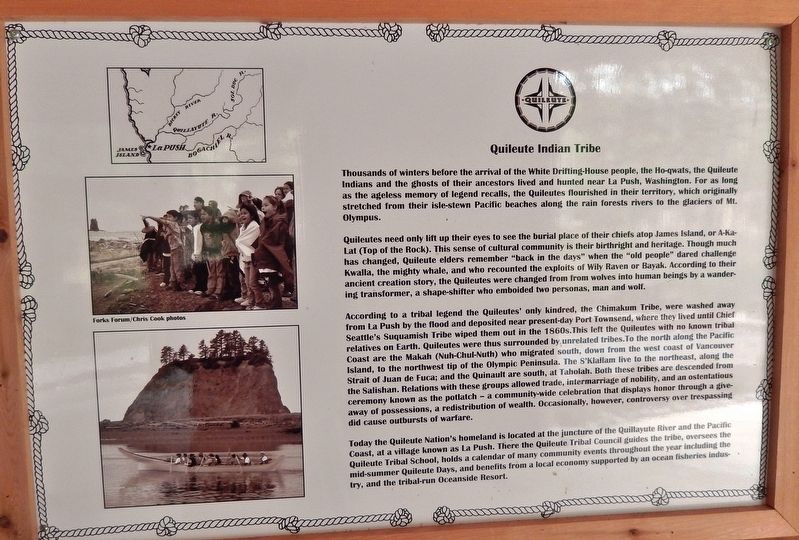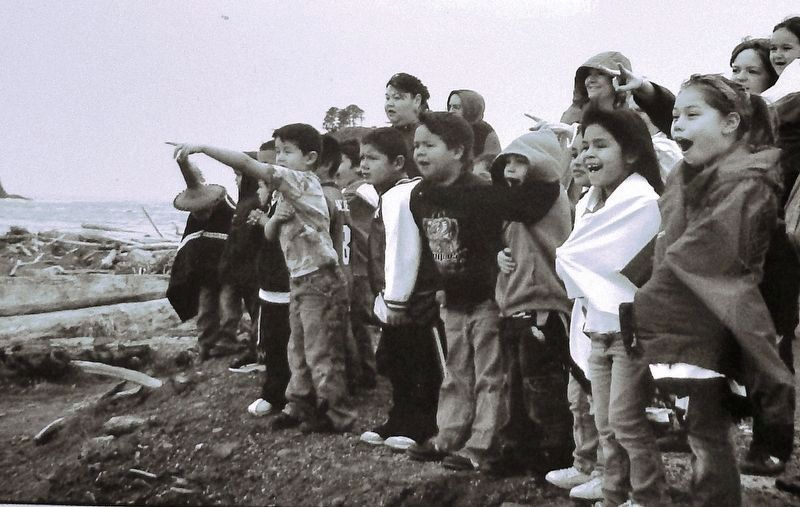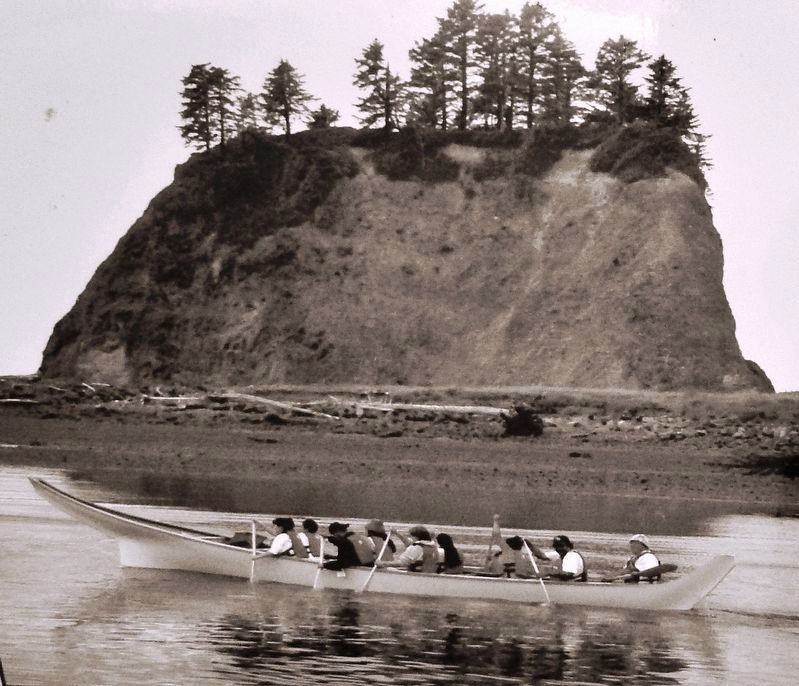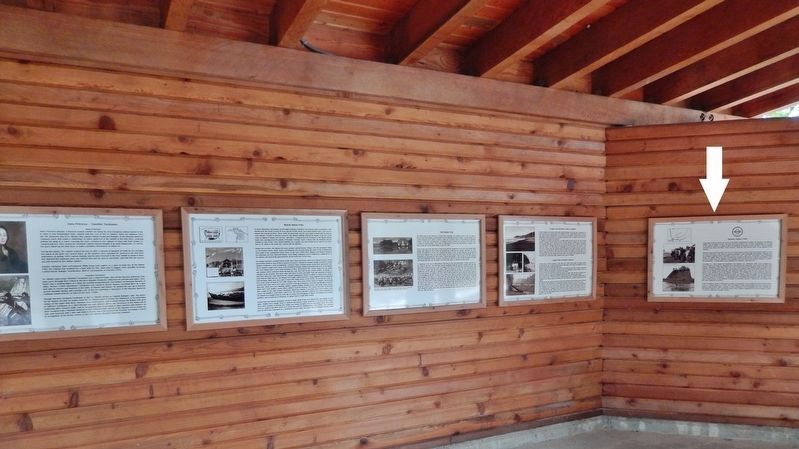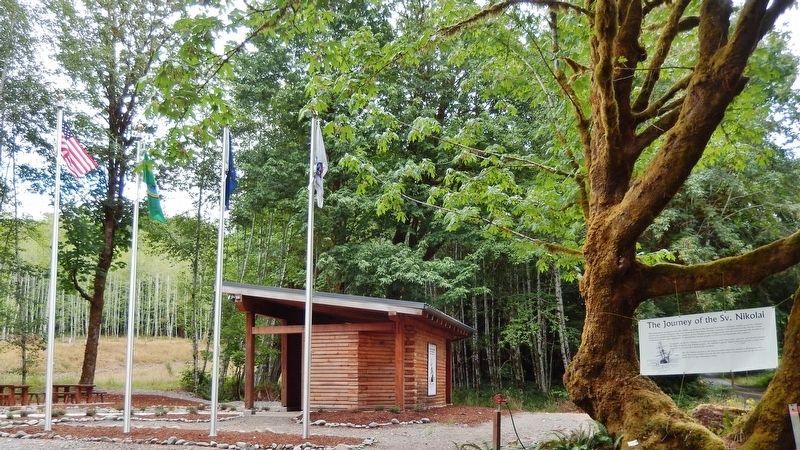Near Forks in Jefferson County, Washington — The American West (Northwest)
Quileute Indian Tribe
Quileutes need only lift up their eyes to see the burial place of their chiefs atop James Island, or A-Ka-Lat (Top of the Rock). This sense of cultural community is their birthright and heritage. Though much has changed, Quileute elders remember "back in the days" when the "old people" dared challenge Kwalla, the mighty whale, and who recounted the exploits of Wily Raven or Rayak. According to their ancient creation story, the Quileutes were changed from wolves into human beings by a wandering transformer, a shape-shifter who embodied two personas, man and wolf.
According to a tribal legend the Quileutes' only kindred, the Chimakum Tribe, were washed away from La Push by the flood and deposited near present-day Port Townsend, where they lived until Chief Seattle's Suquamish Tribe wiped them out in the 1860s. This left the Quileutes with no known tribal relatives on Earth. Quileutes were thus surrounded by unrelated tribes. To the north along the Pacific Coast are the Makah (Nuh-Chul-Nuth) who migrated south, down from the west coast of Vancouver Island, to the northwest tip of the Olympic Peninsula. The S'Klallam live to the northeast, along the Strait of Juan de Fuca; and the Quinault are south, at Taholah. Both these tribes are descended down from the Salishan. Relations with these groups allowed trade, intermarriage of nobility, and an ostentatious ceremony known as the potlatch - a community-wide celebration that displays honor through a give-away of possessions, a redistribution of wealth. Occasionally, however, controversy over trespassing did cause outbursts of warfare.
Today the Quileute Nation's homeland is located at the juncture of the Quillayute River and the Pacific Coast, at a village known as La Push. There the Quileute Tribal Council guides the tribe, oversees the Quileute Tribal School, holds a calendar of many community events throughout the year including the mid-summer Quileute Days, and benefits from a local economy supported by an ocean fisheries industry, and the tribal-run Oceanside Resort.
Erected 2015 by Association of Washington Generals, The Peterson Family, State of Washington, State of Alaska, and American Legion Post 106.
Topics. This historical marker is listed in this topic list: Native Americans.
Location. 47° 49.018′ N, 124° 9.132′ W. Marker is near Forks, Washington, in Jefferson County. Marker can be reached from Upper Hoh Road, 0.1 miles east of Linder Creek Lane, on the left when traveling east. Marker is located in the "Journey of the Sv. Nikolai" interpretive kiosk, on the north side of Upper Hoh Road. Touch for map. Marker is at or near this postal address: 5833 Upper Hoh Road, Forks WA 98331, United States of America. Touch for directions.
Other nearby markers. At least 7 other markers are within 9 miles of this marker, measured as the crow flies. Sv. Nikolai Mission (here, next to this marker); Escape to the Hoh River Leads to Captivity (here, next to this marker); Hoh Indian Tribe (here, next to this marker); Makah Indian Tribe (here, next to this marker); Anna Petrovna - Timothei Tarakanov (here, next to this marker); Fort Ross, California - Sitka Castle, Alaska - Fort Elisabeth, Kaua’i, Hawai’i (here, next to this marker); Rain Forest Monarch (approx. 8.4 miles away).
More about this marker. Marker is a framed interpretive panel mounted at eye-level on the kiosk wall. This monument commemorates the 1808 expedition of the Russian American Company sailing vessel Sv. Nikolai and its crew of 22 explorers who were stranded when their 45-foot schooner went aground on the Pacific Coast north of the Quillayute River.
Related markers. Click here for a list of markers that are related to this marker. The Journey of the Sv. Nikolai
Also see . . . Quileute Indian Tribe. The Quileute hunted sea mammals and fished. They were accomplished whalers and sealers. They built cedar canoes that ranged in capacity from two-man crafts to vessels capable of conveying 6,000 pounds of freight. (Submitted on February 6, 2019, by Cosmos Mariner of Cape Canaveral, Florida.)
Credits. This page was last revised on February 10, 2019. It was originally submitted on February 5, 2019, by Cosmos Mariner of Cape Canaveral, Florida. This page has been viewed 449 times since then and 57 times this year. Photos: 1, 2, 3, 4, 5. submitted on February 7, 2019, by Cosmos Mariner of Cape Canaveral, Florida. • Bill Pfingsten was the editor who published this page.
